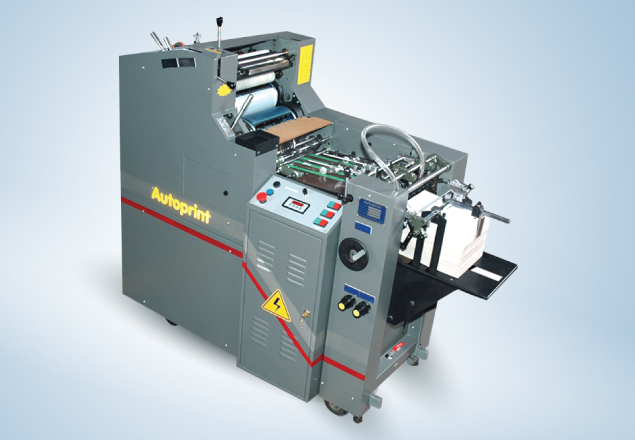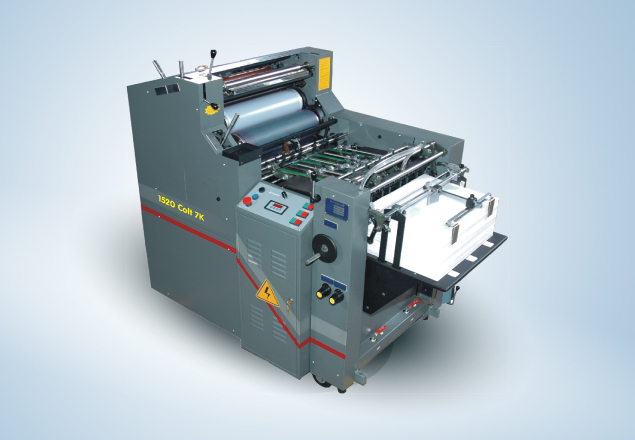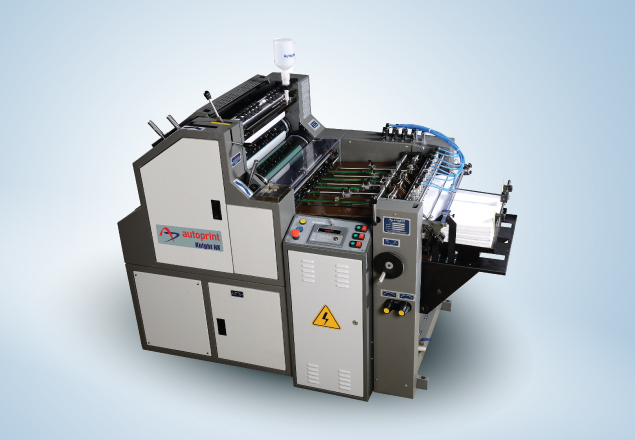Hot Foil Stamping Machine

Hot foil stamping is a decorative printing technique used in the graphic arts and printing industry. It involves the application of a thin layer of metallic or pigmented foil onto a surface using heat, pressure, and a metal die or stamping plate. The foil is typically made of metal, such as gold, silver, or copper, or it can be pigmented to create various colors and effects.
The process of hot foil stamping begins with the creation of a metal die or stamping plate, which contains a raised design or pattern. The foil, wound on a spool, is fed through a hot foil stamping machine. The machine applies heat to the die or stamping plate, and the foil is pressed onto the surface of the material to be stamped using pressure.
The combination of heat, pressure, and dwell time causes the foil to adhere to the surface, creating a metallic or pigmented finish. The stamped design or pattern appears raised and shiny, providing an elegant and eye-catching effect. Hot foil stamping can be applied to various materials, including paper, cardboard, plastics, leather, and more.
Hot foil stamping is commonly used for embellishing products such as book covers, packaging boxes, greeting cards, labels, invitations, and other printed materials. It adds a touch of sophistication, luxury, and visual appeal to these items. The metallic and reflective nature of the foil enhances the perceived value and quality of the finished product.
Overall, hot foil stamping is a specialized printing technique that offers a unique way to enhance the appearance of printed materials and create a premium look and feel.
Components:
Hot foil stamping is a popular technique used in the printing industry to create decorative and metallic finishes on various materials. It involves the application of a thin layer of metallic or pigmented foil onto a surface using heat and pressure
A hot foil stamping machine. , also known as a hot stamping press or foil press, is the equipment used to perform this process. It typically consists of the following components:
- Foil feeding system: This system holds and feeds the foil into the machine. The foil is usually wound on a spool and is pulled through the machine during the stamping process.
- Heating mechanism : The heating mechanism in the machine consists of heating elements, such as heated plates or heating rods. These elements heat up the die or stamping plate, which transfers the heat to the foil.
- Stamping plate or die : The stamping plate, also called a die, is a metal plate or block with a raised design or pattern. It is mounted on the machine and comes into contact with the foil during the stamping process.
- Pressure system: The machine applies pressure to bring the stamping plate in contact with the foil and the substrate. This pressure ensures that the foil adheres to the surface evenly and with sufficient adhesion.
The hot foil stamping process typically involves the following steps:
- Preparation : The design or pattern to be stamped is created on the stamping plate. This plate is then mounted on the machine, and the foil is loaded into the feeding system.
- Heating : The machine is turned on, and the heating mechanism heats up the stamping plate, reaching the desired temperature for the foil to adhere properly.
- Foil feeding : The foil is pulled through the machine and positioned between the stamping plate and the substrate.
- Stamping: The machine applies pressure, pressing the stamping plate onto the foil and the substrate. The combination of heat, pressure, and dwell time ensures that the foil adheres to the substrate, creating the desired design.
- Finishing: Once the stamping is complete, the foil is peeled away, leaving behind the stamped design on the substrate. The finished product can then undergo further processing or be considered complete, depending on the intended application Hot foil stamping machines are used in various industries, including packaging, stationery, leather goods, labels, and more. They offer a versatile and elegant way to enhance the appearance of products and create eye-catching designs.
Process of hot foil stamping machine
The process of hot foil stamping using a hot foil stamping machine typically involves the following steps:
- Preparation : Begin by preparing the design or artwork that you want to hot foil stamp. This design is typically created as a raised pattern or text on a stamping plate or metal die. The stamping plate can be made by etching or engraving the desired design onto a metal surface.
- Setup: Mount the stamping plate or metal die onto the hot foil stamping machine. Ensure that it is securely fixed in place and aligned correctly for accurate stamping.
- Foil Loading : Load the foil onto the machine's foil feeding system. The foil is usually wound on a spool and is fed into the machine during the stamping process. Ensure that the foil is properly positioned and aligned with the stamping plate.
- Heating : Turn on the heating mechanism of the hot foil stamping machine. The heating elements, such as heated plates or heating rods, will warm up to the desired temperature. This temperature is necessary to transfer the foil onto the substrate.
- Stamping : Activate the hot foil stamping machine. It will bring the stamping plate or metal die into contact with the foil and the substrate. The machine applies pressure to ensure proper adhesion and uses heat to transfer the foil onto the substrate. The pressure, heat, and dwell time may vary depending on the specific machine and materials being used.
- Cooling and Release : After the stamping process is complete, the machine releases the pressure and separates the stamping plate or metal die from the substrate. Allow the stamped area to cool before proceeding to the next step.
- Foil Removal : Peel away the excess foil from the stamped substrate. Only the areas where the stamping plate or metal die made contact with the foil will retain the transferred foil.
- Finishing : Inspect the stamped substrate for quality and accuracy. Trim or further process the stamped material as required for the specific application. It's important to note that the specific steps and procedures may vary depending on the type and model of the hot foil stamping machine being used. Always refer to the manufacturer's instructions and guidelines for proper operation and safety precautions.
Purpose of Hot foil stamping machine
The purpose of a hot foil stamping machine is to apply a decorative and metallic finish to various materials. It enables the process of hot foil stamping, which involves the application of a thin layer of metallic or pigmented foil onto a surface using heat, pressure, and a metal die or stamping plate.
The main purposes of a hot foil stamping machine are
- Decorative Finishing : The machine is used to add a decorative element to printed materials, packaging, labels, and other products. Hot foil stamping creates a visually appealing and luxurious effect that enhances the overall appearance and value of the finished item
- Branding and Customization: Hot foil stamping machines are employed to incorporate brand logos, names, or other customized designs onto products. This helps to create a unique and personalized look, making the product stand out and reinforcing brand identity.
- Enhanced Visual Appeal : The metallic or pigmented foil applied through hot foil stamping catches light and adds a reflective quality, giving the stamped design a distinct shine. This enhances the visual appeal of the product, making it more eye-catching and attractive.
- Prestige and Quality Signifier : Hot foil stamping is often associated with premium and high-quality products. The use of metallic foils in gold, silver, or other metallic shades conveys a sense of prestige, luxury, and craftsmanship. It gives the impression of a well-crafted and superior product.
- Versatility: : Hot foil stamping machines can be used on various materials, including paper, cardboard, plastics, leather, and more. This versatility allows for the application of foil stamping on a wide range of products, expanding the creative possibilities and applications in different industries.
Overall, the purpose of a hot foil stamping machine is to provide a precise and controlled method for applying metallic or pigmented foils onto surfaces. It offers a way to add visual interest, branding, and a touch of elegance to printed materials and products, enhancing their overall aesthetic appeal and perceived value.
Advantage of hot foil stamping machine
- Versatility : Hot foil stamping machines can be used on a wide range of materials, including paper, cardboard, plastics, leather, and more. This versatility allows for the application of foil stamping on various products and materials in different industries.
- Decorative and Luxurious Finish : Hot foil stamping creates a visually appealing and luxurious finish. The metallic or pigmented foils add a touch of elegance, enhancing the overall appearance and perceived value of the finished product.
- Durability : Foil stamping offers a durable and long-lasting result. The foil adheres firmly to the surface, providing resistance to scratching, fading, and wear. This makes it suitable for products that need to withstand frequent handling or exposure to environmental conditions.
- Customization and Branding : Hot foil stamping allows for customization and branding options. Logos, names, and other designs can be stamped onto products, providing a unique and personalized touch. This helps in creating brand recognition and differentiation.
- High-Quality and Precise Results: Hot foil stamping machines provide precise control over the application process, resulting in consistent and high-quality stamped designs. The pressure and heat applied ensure a crisp and clear transfer of the foil onto the surface.
Autoprint Hot foil stamping machine
- Digital Controls : Many modern machines come with digital controls that allow for precise temperature and pressure adjustments, ensuring consistent and accurate stamping results.
- Automatic Foil Feeding : Some machines have automatic foil feeding systems that streamline the foil loading process, reducing manual effort and improving efficiency.
- Adjustable Speed : Machines with adjustable speed settings offer flexibility in controlling the stamping process based on the material, design complexity, and desired output.
- Multi-Zone Heating : Advanced machines may feature multi-zone heating systems, allowing for precise temperature control across different areas of the stamping plate or die.
- Foil Saving Mechanism: Certain machines incorporate foil-saving mechanisms that minimize wastage by precisely controlling the amount of foil used for each stamping operation.
- High-Quality Components: Quality hot foil stamping machines are typically built with durable and reliable components, such as robust heating elements and sturdy frames, ensuring longevity and consistent performance.
- High-Quality Components: Quality hot foil stamping machines are typically built with durable and reliable components, such as robust heating elements and sturdy frames, ensuring longevity and consistent performance.
- Safety Features: To ensure operator safety, some machines include safety features such as emergency stops, protective covers, and temperature monitoring systems.


